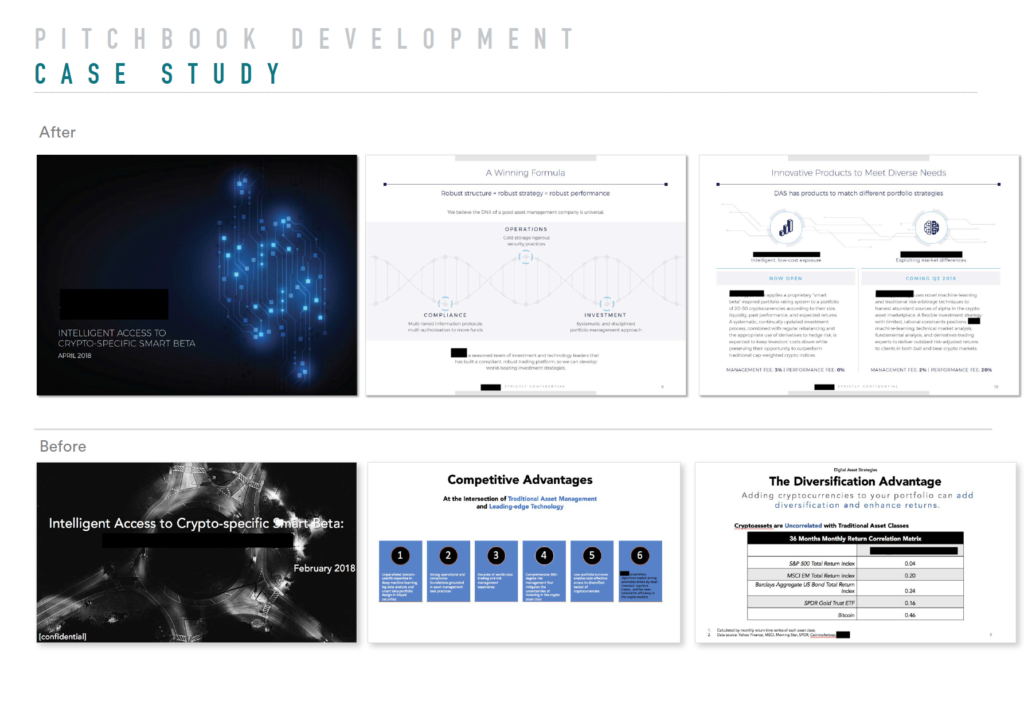A strong pitchbook for one main reason: to make a clear and persuasive case for why investors should invest in their fund.
In our role as financial services marketers, we have seen our fair share of pitchbooks. While some come to us fully formed, the majority aren’t formulated in a way that will drive success with investors, no matter how strong these hedge funds’ performance might be.
Investors are looking beyond performance data. They want to see that you are using next-gen data to support your investment process, attracting and retaining top talent and, increasingly, looking to see if a company has an ESG policy influencing investment decisions. They are also looking for funds that bring something new to the table, although getting this message across to investors can be challenging. More than three-quarters of asset managers feel their messages were differentiated from their peers, but only 21% of consultants believe that managers’ messages varied. (Source)
Here are three tips for sharpening your pitchbook to raise more capital:
Avoid information overload
Trying to fit too much copy onto a single slide is a common mistake. While telling a detailed story might seem like the best way to fully communicate a point, too many words and stats on a page will obscure your message and confuse your audience.
How you describe your strategies in writing can influence investors’ opinions. One study found that managers that demonstrated a well-rounded vocabulary were viewed as being more intelligent and trustworthy. (Source) The study adds that investors could regard confusing sentences and poor syntax as a sign that managers have something to hide. The more text a reader must comb through, the harder it is to appreciate your value proposition.
Quick wins:
- Less is more. Highlight the benefits of your fund in fewer words by focusing your content, writing in an active voice, adopting a more direct tone and, where possible, using bullets.
- Keep it simple. Each slide should have no more than one to two key messages and to focus on the main benefits.
- Punch up headlines. Use compelling headlines to summarize slides and guide readers through your story.
- Use attention-grabbing graphics. Imagery helps investors conceptualize points and helps reduce text .

Grab the reader’s attention
To pique the interest of potential investors, a pitchbook must tell a concise and compelling story about the fund.
The information needs to be organized logically and address the most common questions investors would have about the opportunity.
Your pitchbook should lead with the most important aspects of the fund, and the rest of the presentation should be structured accordingly. This approach helps readers promptly grasp the essentials – the who, what, when, where, why and how – and digest the following pages with ease.
Quick wins:
- Choose your words carefully. Telling a succinct story is an art. Distilling your core messages down into a compelling executive summary takes time, but it’s well worth the effort.
- Time is of the essence. You have a lot to say, but don’t say it all at once. Provide a quick overview of who you are and what you do, and then sell that story in your meeting with investors.
- Sharpen your edge. Summarize your main competitive edge early on and order the rest of the pitchbook according to your key differentiators.
Speak to your audience
A golden rule of marketing is that you should always communicate with your audience’s interests in mind. Building your pitchbook is no different. You need to be aware of what will resonate most with prospective investors when crafting content.
Quick wins:
- Make it accessible. You understand your process, but never assume your reader does. Consider the level of sophistication needed to understand your strategy or the markets you’re targeting, as well as your audience’s expectations.
- Don’t talk down to investors. Individual investors may require more education to understand your story, but don’t make the content dense. They respond better to punchy content, a conversational tone and simple, to-the-point infographics to communicate important concepts.
- Steer them in the right direction. Institutional audiences require less in-depth explanations. However, even savvy investors often need help understanding the opportunity, especially if it’s not their area of expertise. They may respond better to a more formal and informational tone, and appreciate intricate illustrations about your strategy and operation.
Related: The New Normals vs. Eternal Truths


